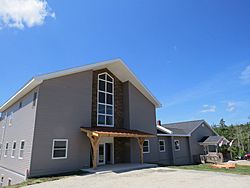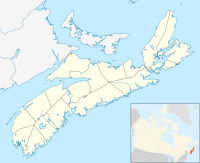Glooscap First Nation facts for kids
Quick facts for kids
Glooscap First Nation
|
|
|---|---|
 |
|
| Motto(s):
A community that is spirited and full of life
|
|
| Country | Canada |
| Province | Nova Scotia |
| County | Kings County |
| Established | 1907 |
| Highest elevation | 100 m (300 ft) |
| Lowest elevation | 40 m (130 ft) |
| Population
(2023)
|
|
| • Total | 434 |
| • Change 2013-23 | |
| Time zone | UTC-4 (Atlantic (AST)) |
| • Summer (DST) | UTC-3 (ADT) |
| NTS Map | 021H01 |
| Website | http://www.glooscapfirstnation.com/ |
| Postal code span: B0P1P0 | |
The Glooscap First Nation is a Mi'kmaq community in Canada. It is located in Nova Scotia, within both Kings County and Hants County. The community is also known as Kluskap.
Their reserve is about 6.4 kilometers from the town of Hantsport. It was created in 1907 and first called Horton 35. The reserve covers about 171.1 hectares of mostly forested land. The community manages its forests carefully.
Glooscap First Nation has several businesses and services. These include a variety store, a gas bar, a Greco Pizza, and a gaming center. They also have a health center, a youth center, and a chapel. The Glooscap Landing Business Park is also owned by the First Nation. This park has another gas bar and a Tim Hortons.
In 2023, the community had 434 people. About 100 of these people lived on the reserve. This makes Glooscap the third-smallest First Nation community in Nova Scotia. Between 2013 and 2023, Glooscap's population grew by 41%.
- Glooscap 35
- Glooscap Landing Reserve
Contents
History of Glooscap First Nation
Glooscap First Nation was established in 1907. The land for the community was bought by Silas Tertius Rand. He was a missionary who worked with the Mi'kmaq people. Rand bought 450 acres of land near Hantsport. This allowed the Mi'kmaq people to earn a living by selling their artwork. The reserve was first named Horton. It was managed by the Annapolis Valley First Nation, which was 30 kilometers away.
Becoming an Independent Community
By 1984, only one family lived in Horton. They were not getting enough services from the Annapolis Valley First Nation. Chief Rita Smith of Annapolis Valley First Nation worked hard to help Horton become independent. In 1984, Horton separated from Annapolis Valley First Nation. It became its own independent First Nation community. Rita Smith became Horton's first Chief. Five families helped start the community: Smith, Peters, Francis, Labrador, and Pictou.
Leaders of the Community
- Rita Smith was Chief from 1984 to 1989.
- Joseph Peters was Chief from 1989 to 1995.
- Shirley Clarke was Chief from 1995 to 2012.
- Sidney Peters has been Chief from 2012 to the present.
In 2001, Horton changed its name to Glooscap First Nation. This was done to honor Glooscap, a legendary hero of the Mi'kmaq people. Glooscap's home was believed to be nearby at Blomidon Provincial Park, Nova Scotia.
Community Governance
The Glooscap First Nation is led by a Chief and a three-person council. The daily operations of the community are managed by a director of administration.
Since 2004, the Glooscap First Nation and the Town of Hantsport have shared a water supply. This shows a good working relationship between the two communities.
Election Process
Glooscap First Nation has its own special election rules. These rules allow the Chief and council members to serve five-year terms.
In 2012, the community held an election. Sidney Peters, who is the brother of former Chief Shirley Clarke, was elected Chief. He won with 55% of the votes. Nearly 80% of the community members voted in this election. Sidney Peters is a fifth-generation Chief from the Peters family.
The new Chief and council made some important changes. They put new rules in place. They also created a new economic development corporation. This was done to make things more clear and to help the community grow in a lasting way.
In 2017, Sidney Peters was re-elected as Chief. He won with a very high percentage of the votes (95%). Two of his brothers were also elected to the council.
In 2022, Sidney Peters was re-elected without anyone running against him. A new council was also chosen that year.
Economic Development
In 2013, the Glooscap First Nation started a new company. This company works independently to improve the economy and future of the community. Its main goal is to build partnerships. These partnerships are with nearby towns, businesses, and organizations. The aim is to benefit the entire region.
In 2015, this company changed its name to Glooscap Ventures. They are now in charge of the $20 million Glooscap Landing Project. They also work on projects related to renewable energy and a seafood company.
In 2017, Glooscap First Nation was recognized for its strong economic growth. They received the 2017 CANDO Indigenous Community Economic Developer of the Year award. This award is given each year to the top Indigenous community in Canada for its economic development efforts.
Notable Members
- Chief Rita Smith (1918–1996) - A significant political figure for the community.
- Amanda Peters - An author.


